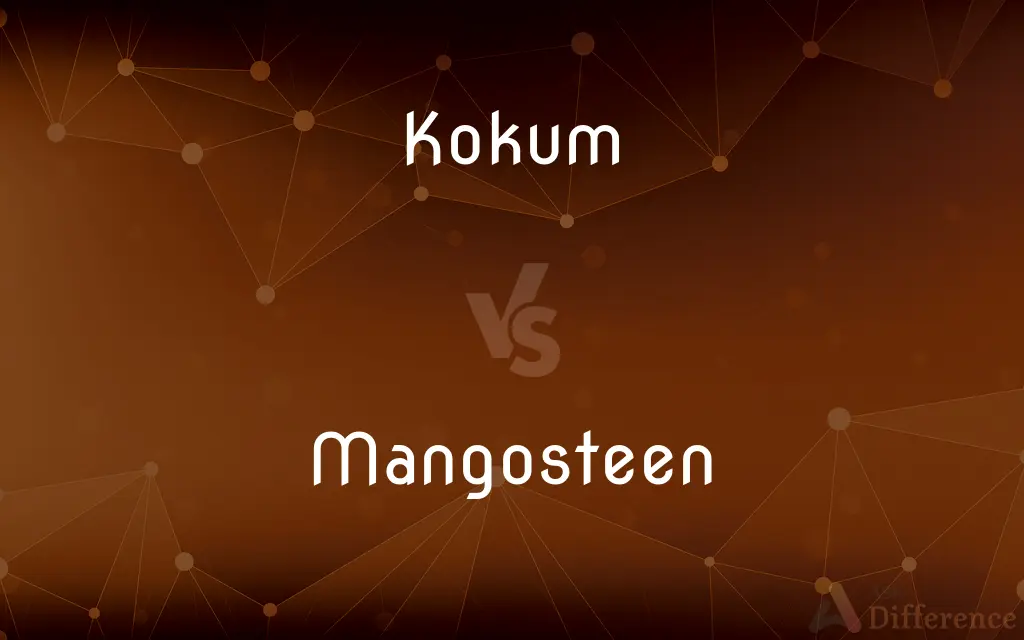Kokum vs. Mangosteen — What's the Difference?
By Tayyaba Rehman & Urooj Arif — Updated on February 23, 2024
Kokum is used in Indian cuisine for its sour flavor, is distinct from mangosteen, a sweet tropical fruit known for its juicy, aromatic segments.

Difference Between Kokum and Mangosteen
Table of Contents
ADVERTISEMENT
Key Differences
Kokum derived from the fruit of the Garcinia indica tree, is renowned in Indian culinary traditions for its tangy flavor and is often used in dishes like curries and beverages for its souring properties. It's also valued for its medicinal benefits, including aiding digestion.
Mangosteen, from the Garcinia mangostana tree, is celebrated for its sweet, slightly tangy flavor profile. The fruit is encased in a thick, purple rind, revealing white, juicy segments inside, and is often eaten fresh or used in desserts and juices.
Kokum serves primarily as a culinary and medicinal ingredient in South Asia, offering a sour taste to various dishes, mangosteen is sought after for its delightful sweetness and is consumed worldwide as a tropical delicacy.
The cultivation of kokum is largely confined to the Western Ghats of India, reflecting its specific regional significance. In contrast, mangosteen is grown in various tropical regions, including Southeast Asia, South America, and Africa, indicating a broader global presence.
The health benefits of both fruits are noteworthy, with kokum being used to combat acidity and gastrointestinal issues, while mangosteen is praised for its antioxidant properties and potential to boost immune health.
ADVERTISEMENT
Comparison Chart
Scientific Name
Garcinia indica
Garcinia mangostana
Origin
Western Ghats, India
Southeast Asia
Taste
Sour
Sweet and slightly tangy
Culinary Uses
Used as a souring agent in curries and drinks
Consumed fresh, used in desserts and juices
Health Benefits
Aids digestion, anti-inflammatory
Antioxidant, boosts immune system
Cultivation
Primarily in India
Southeast Asia, South America, Africa
Appearance
Small, purple fruit with a hard exterior
Large, purple fruit with a thick rind
Edible Parts
Dried rind and seeds
Juicy, white segments inside
Compare with Definitions
Kokum
A sour fruit used in Indian cuisine and traditional medicine.
Kokum sherbet is a popular refreshing drink in India.
Mangosteen
A tropical fruit known for its sweet, tangy flavor and health benefits.
Mangosteen juice is a delicious antioxidant-rich drink.
Kokum
The dried rind of Garcinia indica, known for its culinary and medicinal properties.
She added kokum to the curry for its tangy flavor.
Mangosteen
A dietary source of vitamins and minerals, promoting immune health.
He included mangosteen in his diet for its vitamin C content.
Kokum
A plant native to the Western Ghats of India.
The kokum tree thrives in the humid climate of the Western Ghats.
Mangosteen
Cultivated in various tropical regions for its delightful taste.
Mangosteen trees are a common sight in Southeast Asian orchards.
Kokum
A natural remedy for acidity and digestive issues.
Taking kokum extract helped alleviate his acidity.
Mangosteen
Used in culinary and medicinal preparations worldwide.
The dessert featured fresh mangosteen segments for a tropical flavor.
Kokum
An ingredient in cosmetics and traditional recipes.
Kokum butter is used in skin moisturizing creams.
Mangosteen
The fruit of the Garcinia mangostana tree, with a thick purple rind and juicy segments.
Cutting open the mangosteen revealed its succulent white interior.
Kokum
Garcinia indica, a plant in the mangosteen family with culinary, pharmaceutical, and industrial uses.
Mangosteen
Mangosteen (Garcinia mangostana), also known as the purple mangosteen, is a tropical evergreen tree with edible fruit native to tropical lands surrounding the Indian Ocean. Its origin is uncertain due to widespread prehistoric cultivation.
Mangosteen
An evergreen tree (Garcinia mangostana) of Southeast Asia, having thick leathery leaves and large edible fruit.
Mangosteen
The fruit of this tree, having a hard purple rind containing several white juicy segments.
Mangosteen
A tropical fruit of the tree genus Garcinia.
Mangosteen
(more specifically) A tropical fruit of the tree Garcinia mangostana.
Mangosteen
A tree of the East Indies of the genus Garcinia (Garcinia Mangostana) with thick leathery leaves. The tree grows to the height of eighteen feet, and bears fruit also called mangosteen, of the size of a small apple, the pulp of which is very delicious food.
Mangosteen
Two- to three-inch tropical fruit with juicy flesh suggestive of both peaches and pineapples
Common Curiosities
What are the health benefits of kokum and mangosteen?
Kokum aids in digestion and has anti-inflammatory properties, while mangosteen is known for its antioxidant effects and immune-boosting potential.
Can kokum and mangosteen be used interchangeably in recipes?
Due to their different flavor profiles, kokum and mangosteen are not typically used interchangeably; kokum is for souring dishes, while mangosteen is for sweetening.
What distinguishes kokum from mangosteen in terms of taste?
Kokum is sour and used as a souring agent, whereas mangosteen is sweet and tangy, often eaten fresh.
Are there any cosmetic uses for kokum and mangosteen?
Kokum butter, derived from kokum seeds, is used in skincare, while mangosteen extracts are utilized in some cosmetic products for their antioxidant properties.
Is kokum more of a medicinal or culinary ingredient?
Kokum is valued both for its culinary uses, particularly in Indian cuisine, and its medicinal benefits.
What does kokum taste like?
Kokum has a sour and tangy flavor, which is why it's used as a souring agent in foods.
Why is mangosteen so expensive?
Its cultivation requirements, limited growing regions, and shipping costs contribute to its higher price, especially outside of tropical areas.
How long does it take for a mangosteen tree to bear fruit?
Mangosteen trees take about 7-10 years to begin producing fruit when grown from seed.
Is kokum only used in Indian cuisine?
While most popular in Indian cuisine, kokum's nutritional and medicinal properties have garnered interest internationally.
Where are kokum and mangosteen primarily cultivated?
Kokum is primarily cultivated in India's Western Ghats, while mangosteen is grown in Southeast Asia, South America, and Africa.
How are kokum and mangosteen consumed?
Kokum is used dried or fresh in culinary dishes and medicinal preparations, while mangosteen is mainly consumed fresh, in desserts, or as juice.
What's the best way to store mangosteen?
Mangosteens should be stored at room temperature if consumed soon or refrigerated to extend their shelf life for a few days.
What is the scientific classification of kokum and mangosteen?
Both belong to the Garcinia genus; kokum is Garcinia indica, and mangosteen is Garcinia mangostana.
How do the appearances of kokum and mangosteen differ?
Kokum fruits are small with a hard exterior, whereas mangosteen fruits are larger with a thick, purple rind.
What makes mangosteen a popular fruit globally?
Mangosteen's popularity stems from its distinctive sweet taste, nutritional benefits, and versatile use in various culinary delights.
Share Your Discovery

Previous Comparison
Formal vs. Prom
Next Comparison
Botany vs. ZoologyAuthor Spotlight
Written by
Tayyaba RehmanTayyaba Rehman is a distinguished writer, currently serving as a primary contributor to askdifference.com. As a researcher in semantics and etymology, Tayyaba's passion for the complexity of languages and their distinctions has found a perfect home on the platform. Tayyaba delves into the intricacies of language, distinguishing between commonly confused words and phrases, thereby providing clarity for readers worldwide.
Co-written by
Urooj ArifUrooj is a skilled content writer at Ask Difference, known for her exceptional ability to simplify complex topics into engaging and informative content. With a passion for research and a flair for clear, concise writing, she consistently delivers articles that resonate with our diverse audience.















































